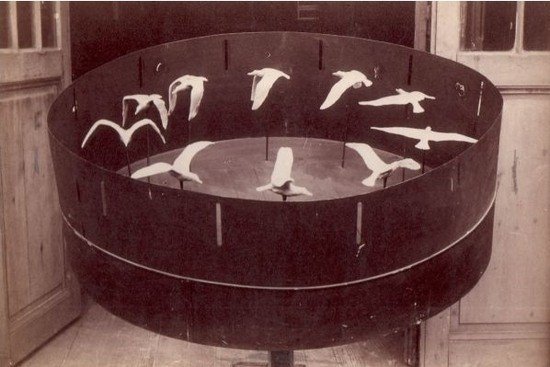Gay Rights Movement 1970s Fashion 1970s
Hollywood: Mayhap no other identify on earth evokes the same air of bear witness-business organisation magic and glamour. The legend of Hollywood began in the early 20th century and is an earmark of modern American society rich in history and innovation.
The Origin of Movies

The origin of movies and move pictures began in the late 1800's, with the invention of "motion toys" designed to trick the eye into seeing an illusion of motion from a display of withal frames in quick succession, such as the thaumatrope and the zoetrope.
The First Moving-picture show

In 1872, Edward Muybridge created the outset motion-picture show ever fabricated by placing twelve cameras on a racetrack and rigging the cameras to capture shots in quick sequence every bit a horse crossed in forepart of their lenses.
Recommended Reading
The first film for move photography was invented in 1885 by George Eastman and William H. Walker, which contributed to the accelerate of movement photography. Shortly thereafter, the brothers Auguste and Louis Lumiere created a hand-cranked car called the cinematographe, which could both capture pictures and project however frames in quick succession.
1900s Movies
The 1900's were a time of great advancement for motion-picture show and move picture engineering. Exploration into editing, backdrops, and visual flow motivated aspiring filmmakers to push into new creative territory. One of the primeval and most famous movies created during this time was The Smashing Train Robbery, created in 1903 by Edwin S. Porter.
Around 1905, "Nickelodeons", or 5-cent motion-picture show theaters, began to offer an easy and inexpensive mode for the public to watch movies. Nickelodeons helped the movie industry move into the 1920'south past increasing the public entreatment of moving picture and generate more money for filmmakers, alongside the widespread apply of theaters to screen World War I propaganda.
The end of Globe War I ushered the United States into a cultural smash, a new industry eye was on the rise: Hollywood, the home of motion pictures in America.
1910s Hollywood
Co-ordinate to industry myth, the beginning movie fabricated in Hollywood was Cecil B. DeMille'south The Squaw Man in 1914 when its director decided last-infinitesimal to shoot in Los Angeles, merely In Onetime California, an earlier film past DW Griffith had been filmed entirely in the hamlet of Hollywood in 1910.
Notable actors of this menstruum include Charlie Chaplin.
Past 1919, "Hollywood" had transformed into the face of American cinema and all the glamour it would come to embody.
1920s Hollywood
The 1920's were when the picture industry began to truly flourish, along with the nascency of the "movie star". With hundreds of movies being fabricated each year, Hollywood was the rising of an American forcefulness.
Hollywood lone was considered a cultural icon set apart from the rest of Los Angeles, emphasizing leisure, luxury, and a growing "political party scene".
This age as well saw the ascension of two coveted roles in the moving picture manufacture: the manager and the star.
Directors began to receive greater recognition for using and trademarking personal styles in the creation of their films, which previously in history had not been possible due to limitations in filmmaking engineering science.
Additionally, picture stars began to receive greater fame and notoriety due to increases in publicity and shifts in American trends to value faces from the big screen.
The United States Offset Pic Studio

The 1920s also saw the founding of the first movie studio in the Usa.
On April iv, 1923, four brothers, Harry, Albert, Sam, and Jack Warner used money loaned by Harry'south banker to officially incorporated their company Warner Brothers Pictures.
1930s Hollywood
The 1930's was considered the Golden Age of Hollywood, with 65% of the U.s.a. population attending the cinema on a weekly ground.
A new era in picture show history began in this decade with the industry-wide movement towards sound into moving picture, creating new genres such as action, musicals, documentaries, social statement films, comedies, westerns, and horror movies, with stars such equally Laurence Olivier, Shirley Temple, and director John Ford rising to rapid fame.
The use of audio tracks in motion pictures created a new viewer dynamic and as well initiated Hollywood'due south leverage in the upcoming World War 2.
1940s Hollywood
The early 1940's were a tough fourth dimension for the American motion-picture show industry, especially after the attack on Pearl Harbor past the Japanese. However, production saw a rebound due to advances in technology such as special furnishings, meliorate sound recording quality, and the first of colour film apply, all of which made movies more than modern and appealing.
Similar all other American industries, the picture show industry responded to World War II with increased productivity, creating a new wave of wartime pictures. During the war, Hollywood was a major source of American patriotism by generating propaganda, documentaries, educational pictures, and general awareness of wartime demand. The twelvemonth 1946 saw an all-time loftier in theater attendance and full profits.
1950s Hollywood
The 1950's were a time of immense modify in American civilization and around the globe. In the post-war United states, the boilerplate family grew in affluence, which created new societal trends, advances in music, and the rise of popular civilization – peculiarly the introduction of television sets. By 1950, an estimated x million homes owned a television set.
A shift in demographics created a change in the film industry'southward target market, which began creating material aimed at American youth. Instead of traditional, arcadian portrayals of characters, filmmakers started creating tales of rebellion and rock n' roll.
This era saw the ascent of films featuring darker plot lines and characters played past "edgier" stars like James Dean, Marlon Brando, Ava Gardner, and Marilyn Monroe.
The entreatment and convenience of television receiver caused a major pass up in pic theater attendance, which resulted in many Hollywood studios losing money. To adapt to the times, Hollywood began producing film for Television receiver in order to make the coin it was losing in movie theaters. This marked the archway of Hollywood into the television industry.
1960s Hollywood
The 1960's saw a swell push for social modify. Movies during this time focused on fun, way, rock n' ringlet, societal shifts like the civil rights movements, and transitions in cultural values.
It was as well a fourth dimension of change in the world'due south perception of America and its culture, largely influenced by the Vietnam War and continuous shifts in governmental power.
1963 was the slowest year in movie product; approximately 120 movies were released, which was fewer than any year to date since the 1920'south. This refuse in production was caused by lower profits due to the pull of television. Movie companies instead began to make money in other areas: music records, movies fabricated for TV, and the invention of the TV series. Additionally, the average film ticket price was lowered to just a dollar, in an attempt to depict more than patrons to the picture palace.
Past 1970, this caused a depression in the motion picture industry that had been developing over the past 25 years. A few studios still struggled to survive and fabricated money in new ways, such every bit theme parks like Florida'south Disney World. Because of fiscal struggles, national companies bought out many studios. The Gold Age of Hollywood was over.
1970s Hollywood
With the Vietnam War in total swing, the 1970's began with an essence of disenchantment and frustration within American civilization. Although Hollywood had seen its everyman times, during the late 1960'southward, the 1970'southward saw a blitz of creativity due to changes in restrictions on language, sex, violence, and other strong thematic content. American counterculture inspired Hollywood to take greater risks with new alternative filmmakers.
Latest Entertainment Articles
The rebirth of Hollywood during the 1970's was based on making loftier-action and youth-oriented pictures, usually featuring new and dazzling special furnishings technology.
Hollywood's financial problem was somewhat alleviated with the then-shocking success of movies like Jaws and Star Wars, which became the highest-grossing movies in movie history (at that time).
This era also saw the appearance of VHS video players, laser disc players, and films on video cassette tapes and discs, which greatly increased profits and revenue for studios. Nonetheless, this new option to view movies at abode once again caused a decrease in theater omnipresence.
1980s Hollywood
In the 1980's, the past inventiveness of the film industry became homogenized and overly marketable. Designed only for audience appeal, about 1980'southward characteristic films were considered generic and few became classics. This decade is recognized as the introduction of high concept films that could be easily described in 25 words or less, which made the movies of this time more marketable, understandable, and culturally accessible.
By the end of the 1980's, it was more often than not recognized that films of that time were intended for audiences who sought uncomplicated entertainment, every bit most pictures were unoriginal and formulaic.
Many studios sought to capitalize on advancements in special effects engineering, instead of taking risks on experimental or thought-provoking concepts.
The future of film looked precarious as production costs increased and ticket prices continued to drop. Only although the outlook was bleak, films such as Return of the Jedi, Terminator, and Batman were met with unexpected success.
Due to the use of special effects, the budget of flick production increased and consequently launched the names of many actors into overblown distinction. International large business eventually took fiscal control over many movies, which allowed foreign interests to own properties in Hollywood. To salve money, more and more films started to launch production in overseas locations. Multi-national industry conglomerates bought out many studios, including Columbia and 20th Century Play tricks.
1990s Hollywood
The economical decline of the early 1990'southward caused a major decrease in box office acquirement. Overall theater attendance was up due to new multiscreen Cineplex complexes throughout the Us. Employ of special furnishings for violent scenes such every bit battlefield scenes, car chases, and gunfights in high-budget films (such every bit Braveheart) was a primary appeal for many moviegoers.
Meanwhile, pressure on studio executives to make ends see while creating hit movies was on the rise. In Hollywood, movies were becoming exorbitantly expensive to make due to higher costs for motion-picture show stars, agency fees, ascent production costs, advertizing campaigns, and crew threats to strike.
VCR's were still popular at this time, and profits from video rentals were higher than the sales of pic tickets. In 1992, CD-ROM'due south were created. These paved the fashion for movies on DVD, which hit stores past 1997. DVD'south featured a much better paradigm quality as well as the capacity for interactive content, and videotapes became obsolete a few years later.
2000s Hollywood

The turn of the millennium brought a new historic period in film history with rapid and remarkable advances in engineering. The movie industry has already seen achievements and inventions in the 2000'due south, such as the Blu-ray disc and IMAX theaters.
Additionally, movies and Television shows can at present exist watched on smartphones, tablets, computers, and other personal devices with the advent of streaming services such as Netflix.
Explore More Entertainment Articles
The 2000'due south have been an era of immense modify in the movie and engineering science industries, and more alter is sure to come quickly. What new innovations will the future bring us? Only time will tell.
READ More: Shirley Temple
0 Response to "Gay Rights Movement 1970s Fashion 1970s"
Post a Comment